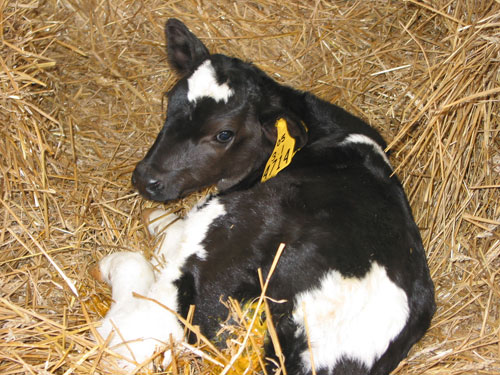 Sick calves are no fun. At the beginning of July, my research group started a study with sixty newborn bull calves from commercial dairy farms. Our objective is to find combinations of milk replacer and starter grain additives that promote calf performance and health in the absence of medicated milk replacer. Let’s take a look at some of the reasons for calf scours, strategies to prevent it, and protocols to treat calves when these challenges arrive at a calf hutch near you.
Sick calves are no fun. At the beginning of July, my research group started a study with sixty newborn bull calves from commercial dairy farms. Our objective is to find combinations of milk replacer and starter grain additives that promote calf performance and health in the absence of medicated milk replacer. Let’s take a look at some of the reasons for calf scours, strategies to prevent it, and protocols to treat calves when these challenges arrive at a calf hutch near you.
According to the USDA-National Animal Health Monitoring Survey, calf scours and subsequent dehydration is the number one cause of calf mortality prior to weaning. Calf scours can be due to infection in the intestine by viruses, bacteria, and protozoa. It can also be caused by inadequacies in the feeding program including poor sanitation, failure of passive transfer (feeding insufficient quantity and/or quality of colostrum), inconsistent delivery of milk or milk replacer, and poor housing conditions. When scouring, calves lose considerable water and electrolytes (minerals such as sodium, phosphorous, potassium, chloride, and others).
My experience has been that solving calf scour problems requires three things: 1) long term commitment to identifying and solving problems in the overall calf program, 2) early identification and aggressive treatment and care of calves with scours, and 3) continued monitoring and evaluation of the calf program (including accurate record keeping), and a willingness to remain flexible in the face of ever changing challenges to calf health.
Here are my top ten strategies for preventing and treating calf scours.
- Colostrum feeding and management is key. Feed adequate amounts (10% of calf body weight) of heat treated (140°F for 30 minutes) colostrum within the first 24 hours after birth. Properly sanitize the mammary gland prior to timely harvesting of colostrum. Test colostrum with a colostrometer, heat treat, place in a labeled container, and quickly refrigerate. Freeze excess colostrum (if will not be fed in 3 days).
- After providing adequate colostrum on day one, consider feeding a second dose after the first 24 hours (especially useful in stressed calves). It is thought that immunoglobulins in colostrum will coat the small intestine and prevent attachment and colonization by pathogens. Additionally, colostrum provides an excellent source of energy and contains compounds such as lactoferrin and fatty acids that benefits the calf.
- It is important to meet the calf’s requirements for nutrients; however, slowly bringing calves onto milk replacer may help reduce the risk of digestive upset in stressed calves.
- During the first fourteen days, calves should be observed at least three times daily. Check calf disposition (especially alertness of ears), presence of nasal discharge, fecal score (1 = normal, 4 = watery scours), and consumption of milk replacer (speed and completeness of drinking). If calves trip any one of these warning signs, be aggressive and select a course of treatment or observation.
- Act quickly at the first sign of scours. Our protocol includes dosing electrolytes and stool corrective solution, injection of antibiotics, intravenous injection of sterile saline or sterile sodium bicarbonate in severe cases of dehydration, and recording of all treatments and communication with staff using paint-chalk, dry-erase boards, and electronic records.
- Consider using feed additives in milk replacer to promote gut health. New FDA regulations have changed the way we feed antibiotics in milk replacer. Neomycin sulfate and oxytetracycline (NT) can be included in milk replacer in a 1:1 ratio (1600 g/ton of each drug) or added to non-medicated milk replacer to treat calf scours caused by bacteria. This new higher level of NT is to be fed for a minimum of seven days and a maximum of fourteen days. Many other feed additives are available for improving calf gut health including plasma IgG products, colostrum (both maternal and colostrum replacers) and yeast cell wall extracts.
- Provide quality housing. All calves require clean and dry bedding, freedom from thermal stress and parasites, and good quality air.
- Work with your veterinarian and nutritionist to develop protocols for treating calf scours, ensure all employees understand the protocols and that protocols are posted and updated regularly and that employees are adequately trained to carry out protocols. Make sure everyone understands the causes of non-compliance to these protocols.
- Ensure that all feeding equipment is properly sanitized and in good working order.
- Double check milk replacer mixing recipes, use measures of total solids at the beginning and end of chores to evaluate consistency of mixing, provide a thermometer and guidelines to ensure that milk is being mixed and fed at the correct temperature.
Summary:
Calf mangers can combat scours with three steps: 1) replace the water and electrolytes calves are losing, 2) kill or reduce the organism(s) causing the infection, 3) minimize the risk of secondary infections.
Source: University of Minnesota Dairy Extension











